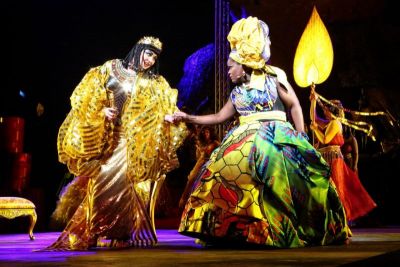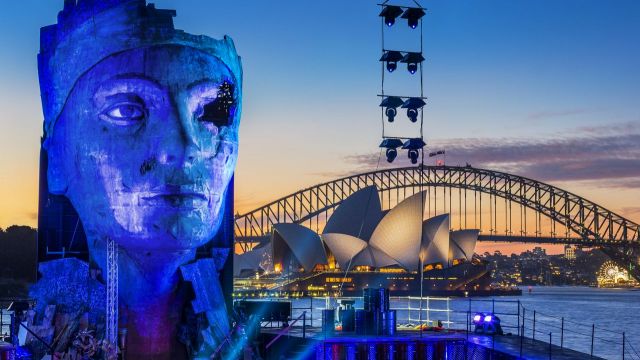AIDA
It’s a warm, autumn Sydney evening. In the clear, blue sky a half moon rises and the evening star twinkles. The Bridge stretches across the horizon, the harbour swells gently – and the giant head of Nefertiti hovers above a stage that appears to float out from the Fleet Steps of the Botanic Gardens. Such is the magical setting for the 2015 Handa Opera on Sydney Harbour production of Verdi’s Aida.
Behind the huge grandstand (it seats 3001!) the opening night audience arrives along paths where the Moreton Bay figs are illuminated, heralding the Egyptian blue theme that will prevail through stage and costume design. There is an expectant energy and a buzz as drinks are sipped and seats taken. For many this is their first taste of opera, and these productions certainly promote the form in a spectacular way.
And spectacle is really what it’s all about! It must have been a logistic nightmare to plan and build the set and co-ordinate the whole technical side of the production. The stage itself, which stands on 16 pylons drilled into the ocean floor, weighs 40 tonnes. Nefertiti’s head is 18 metres tall and weighs 15 tonnes! A giant loom carries over 12 tonnes of rigging to light the action from multiple angles and amplify the music through 223 speakers.
Add to this, the orchestra pit below the stage, the floating walkway that takes the performers to the stage, the stairs that take them high above the stage, and the infrastructure behind and below the stage that allows Nefertiti to turn and transform into an intricately decorated throne that is almost dwarfed by the azure blue feathers that stretch high into the night above it.

On such a setting, the performers need to appear similarly spectacular and designer Mark Thompson has taken director Gale Edwards’ belief that past and present can be juxtaposed in an opera set in an ancient Egypt torn by conflict not dissimilar to Egypt today. Thus, in this production images from classical and modern Egypt are blended. Security guards in suits and dark glasses and soldiers in contemporary uniforms stand beside the exotic colours of Ethiopian slaves and warriors; elegant gold evening gowns and dress suits beside the elaborately decorated costumes of high priests and the blue cowled habits of lesser officials.
The costumes of Aida and other Ethiopian slaves are intricate pieces of design, colour and stitching, each one using over 20 metres of fabric! The costumes of her mistress Amneris pick up the juxtaposition of time, in some scenes elaborately ancient Egyptian, in others the classic simplicity of a long, sleeveless, midnight blue contemporary gown.
So much for the spectacle! What about the opera? After all, it’s the music and singing that opera is all about. The orchestra, led by Brian Castles-Onion, sounded stunning, the amplification accentuating the drama and power of Verdi’s music.
The voices of the opening night cast, principals and chorus alike, were equally enthralling. Individual voices rang clearly into the night, but when two, three or four sang in harmony, the amplification tended to blend and merge the voices a little too closely losing the subtleties of the harmonies.

What a privilege to hear the power and immaculate control of American soprano Latonia Moore as Aida, singing of her sad plight as she has done in New York, London, Zurich, Tokyo and opera houses across the United States since her debut performance of the role in 2012. The sober notes of Walter Fraccaro as Radames echo their ‘star-crossed’ love; and the beautiful voice of Milijana Nikolic as Amneris comes constantly between them, especially in the final moments of the opera as she sings high inside the statue of Nefertiti as the lovers face their death.
Michael Honeyman plays Amonasro, David Parkin plays Ramfis and Gennardi Dubinsky plays the King. Eva Kong makes a short but wonderful appearance as the High Priestess, her costume and voice equally thrilling. With them, and behind them, is the chorus, making Verdi’s music ring even more strongly across the harbour.
Musically and as a spectacle, this is a treat. However, there were some small disappointments. The co-ordination of the choreography on opening night inferred that a little more rehearsal was needed. For example, several scenes involving the soldiers and ‘security’ staff and flags were spoilt by being out of synch. Despite the enormity of the organisation of a production such as this, these are things that define the production, and on opening night they need to be right. As well, some special effects that occur directly in front of the stage are invisible to the hundreds of patrons sitting at either side, and this is a little disappointing.
That being said, Aida is one of the best-known operas by the most famous of Italian opera composers, and setting it in one of the most beautiful harbours in the world is a treat audiences will remember for a long time. Credit must go to the creative vision of the director, to the designers, engineers and construction co-ordination team that manage, in such a short time, to mount all aspects of the production, to the orchestra, to the cast who have weathered 200 hours of rehearsal time, and to the stage crew and operators who work their miracles behind the scenes.
Carol Wimmer.
Images: (top) Opera Australia's Handa Opera on Sydney Harbour – Aida. Photographer: Hamilton Lund, (middle) Milijana Nikolic as Amneris and Latonia Moore as Aida & (lower) Latonia Moore as Aida and Michael Honeyman as Amonasro. Photograoher: Prudence Upton.
Subscribe to our E-Newsletter, buy our latest print edition or find a Performing Arts book at Book Nook.

